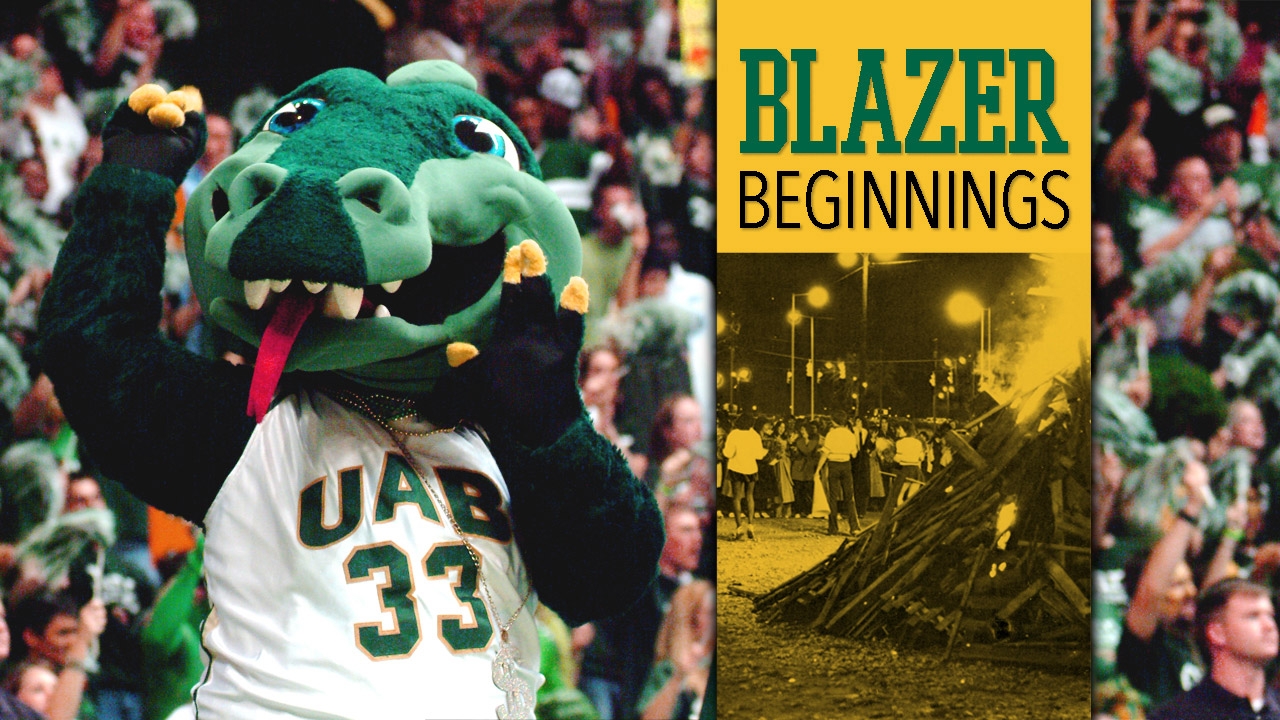Welcome to Birmingham. Here there be dragons. And a sea of green and gold. And a curious competition involving old hospital gurneys.
With a record number of students and a historic year ahead for Blazer athletics, UAB’s classic traditions are finding new fans, both on campus and throughout the city. Blaze, for example, has become a social media star.
But how did some of these traditions begin? Who birthed the name “Blazers,” for instance? And how did we end up with green and gold instead of 1970s-chic white and rust? Then, as now, students were the driving force for many traditions, leaving a legacy through their creativity and school spirit. UAB Magazine took a trip through time to share a few origin stories:
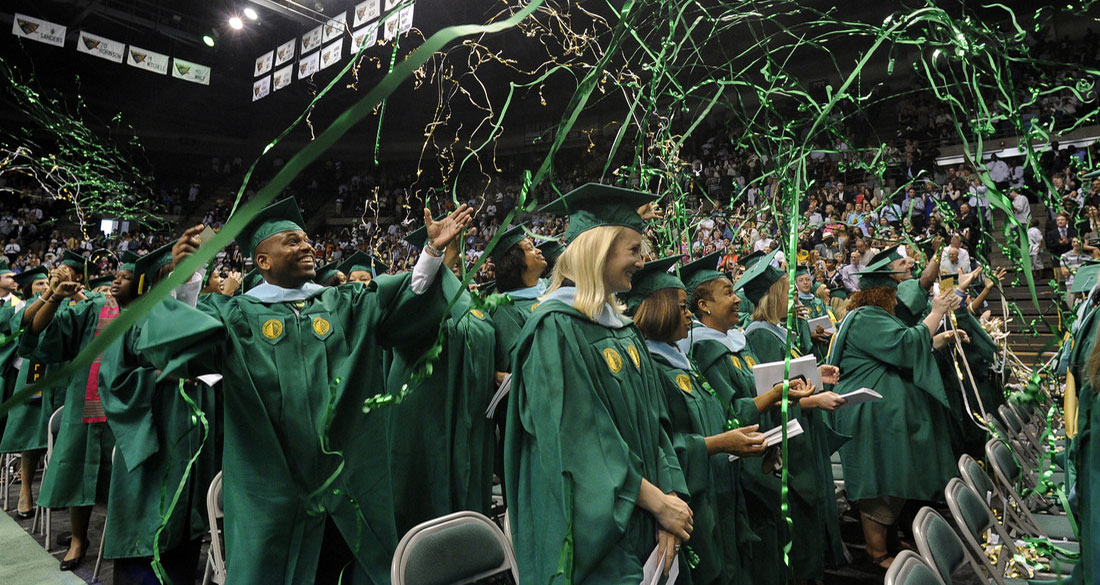 Bartow Arena is awash in green and gold at the 2011 commencement ceremony. UAB actually has three official colors: green and white, with gold as the accent color. Photo by Steve Wood.
Bartow Arena is awash in green and gold at the 2011 commencement ceremony. UAB actually has three official colors: green and white, with gold as the accent color. Photo by Steve Wood.
GREEN AND GOLD
The selection of school colors was a hot topic among students at the newly independent UAB. Under the headline “Color and Controversy,” a front-page blurb in a March 1970 Kaleidoscope student newspaper declared, “There’s been a lot of rap going on about the colors,” with students, faculty, and administrators voicing their opinions. Below the blurb, readers could clip out a form, suggest their own color combinations, and submit them to the paper or the Student Government Association (SGA).
Around that time, Chuck Snow, a student majoring in radiologic technology from Walker County, Ala., was summoned to the office of Joseph Volker, D.D.S., Ph.D., UAB’s first president—and he was nervous. Snow, a member of the student entertainment committee, was tasked with bringing concerts, lectures, and films to campus, and he “was sure I had done something terrible,” he recalls. “I had put a flashing sign advertising a Chicago concert on the lawn of one of the academic buildings, and I thought I was being called on the carpet for that.”
Instead, Snow found himself among a group of students from the entertainment committee and the SGA. Volker’s staff gave them a mission: Come up with some school colors ASAP. The group went through a rainbow of combinations, but other schools already were using most of them, Snow recalls.
“We had to find something symbolic of UAB and what we do,” says Snow, who graduated in 1972. “Life sciences are a big deal here. Green signifies life more than anything else—but what could go with that? Then I thought about King Midas. Everything he touched turned to gold.
“So life and prosperity. Green and gold. I shared my thoughts with the others in the room, and they liked it,” Snow says. Volker’s staff must have liked the suggestion, too. In the summer of 1970, green and gold was among six color combinations voted upon by students, faculty, and staff.
Green and gold emerged victorious with 231 votes. Runners up included blue and white, with 147 votes, and white and rust, with 93 votes. Other contenders included green and gray, red and gray, and red and blue.
Volker didn’t act on the results, writes former UAB dean Tennant McWilliams, Ph.D., in New Lights in the Valley, his 2007 history of the university. But UAB education professor and commencement planner Virginia Horns-Marsh, Ph.D., did. In an interview shared in McWilliams’s book, she recalls Volker requesting bright colors to decorate the spring 1971 ceremony. Her solution? Green and gold flowers.
Green and gold now symbolize Birmingham as much as red iron ore once did. Snow, whose career in clinical radiologic technology took him to cities across Alabama, was surprised to see how much the colors had taken root—from buildings to signs to t-shirts—when he returned to UAB for a job years after his graduation.
For Snow, now retired, the colors are a reminder of an exciting time at a young university. “The campus was rather quaint then,” he says, but as part of the entertainment committee, “we were hitting on all eight cylinders trying to do everything we could to enhance student life.”
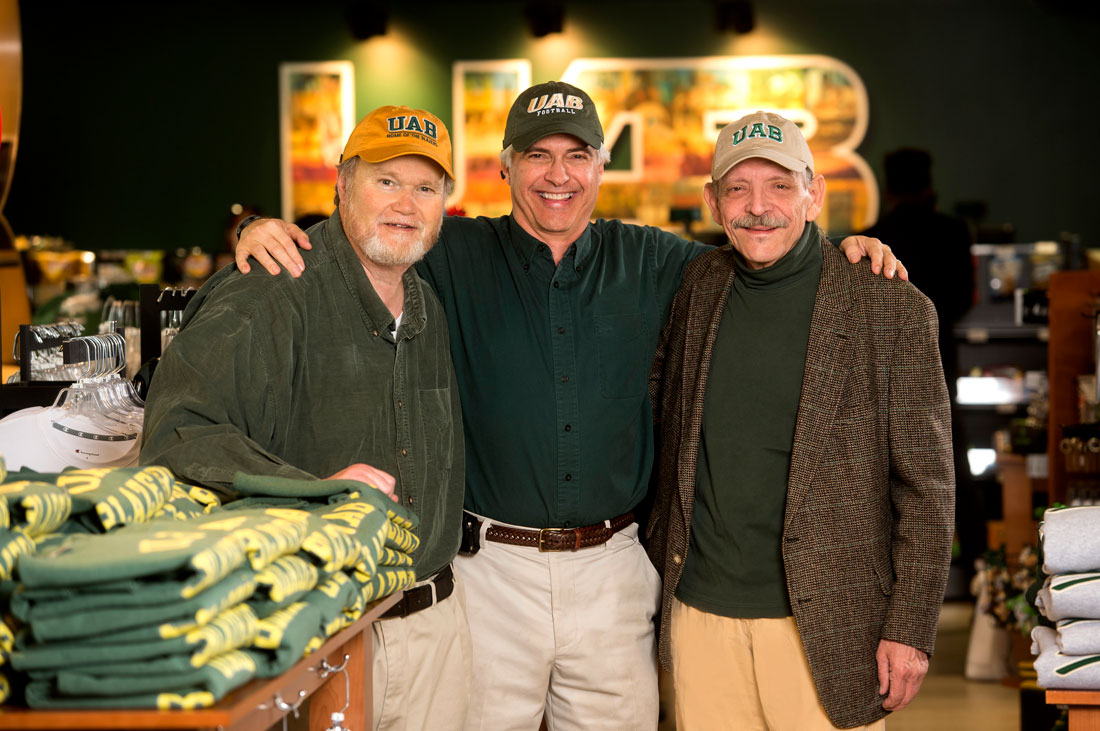 (Left to right) Alumni Tommy Burns, Richard Dewberry, and Chuck Snow, who helped establish iconic UAB traditions as students, show their school spirit at the UAB Bookstore. UAB’s colors aren’t Snow’s only lasting cultural contribution: As a student on the entertainment committee, he hired a young, little-known band—the Commodores, led by Lionel Richie—to headline a party for UAB nursing students. After they played in a basement room on campus, Snow introduced the band to its first booking agency. Photo by Steve Wood.
(Left to right) Alumni Tommy Burns, Richard Dewberry, and Chuck Snow, who helped establish iconic UAB traditions as students, show their school spirit at the UAB Bookstore. UAB’s colors aren’t Snow’s only lasting cultural contribution: As a student on the entertainment committee, he hired a young, little-known band—the Commodores, led by Lionel Richie—to headline a party for UAB nursing students. After they played in a basement room on campus, Snow introduced the band to its first booking agency. Photo by Steve Wood.
THE BLAZERS
Can you imagine Birmingham cheering for the Barons—on a basketball court? In 1977, that was one suggestion tossed around for UAB’s team name. But Tommy Burns, then a history major, had another idea.
The Birmingham native remembers being called to the SGA president’s office to talk basketball. Everyone on campus and in the community was abuzz about UAB’s new men’s basketball team, which would tip off for the first time in the fall of 1978. But first, the team needed a name. In his book, McWilliams notes that a committee of students, faculty, and administrators had been soliciting ideas from students, employees, and the public via “Name Our Team” forms. In the SGA office, Burns, an early member of UAB’s Sigma Phi Epsilon chapter who was active in cultivating student life, joined several fellow students for a name brainstorming session.
“We went around the room,” Burns says. “I came out with ‘Trailblazers,’ because the Portland Trailblazers were about to win the NBA championship. And somebody said no, because that would be too much like them, and it’s too long—it won’t fit on a marquee.” Other names were suggested, discussed, and argued, including Barons. (At that time, the original Birmingham Barons baseball team was defunct.) “This went on for a while,” Burns says. So he circled back around with a shortened version of his original suggestion: Blazers. “My thought was that this was the first team; they were blazing the trail,” Burns says.
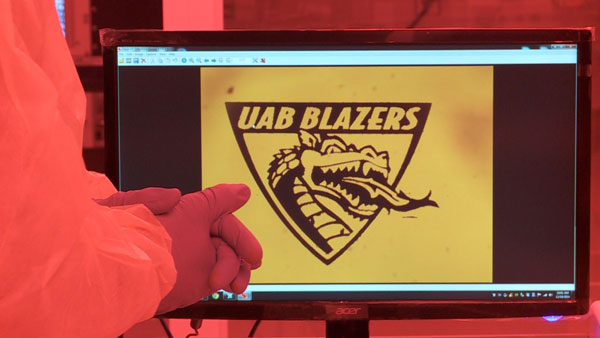 Even the scientists in UAB's Center for Nanoscale Materials and Biointegration show their Blazer spirit. Photo by Steve Wood.
Even the scientists in UAB's Center for Nanoscale Materials and Biointegration show their Blazer spirit. Photo by Steve Wood.
Several others on campus also considered “Blazers” the perfect moniker for UAB athletics. A scrapbook at UAB Archives includes four “Name Our Team” forms from students Eddie Smith, Edward Gilchrist, and Glenn P. Ward, all of whom suggested Blazers. McWilliams’s book credits Smith and student Ted Greer with the big idea.
Burns recalls that the brainstorming meeting ended with attendees choosing four names—Blazers, Barons, Titans, and Warriors—for an election among students, faculty, and staff. In January 1978, the campus “voted overwhelmingly in favor of the Blazers” as the name for its intercollegiate teams, Burns recalls.
Burns, who became a video and audio producer after graduating in 1979, recalls the UAB of that era as a “hidden diamond,” already exhibiting the diversity of students that, in recent years, has earned national accolades from The Princeton Review.
“You had Vietnam veterans returning. You had people from different colleges who had come back home. UAB gave all of them the chance to get a very good education,” Burns says. “You had people from many areas of the city—and people of all religious beliefs, races, nationalities, and sexual orientations—going to school and being friends. UAB to me is a place where diverse people come together, and they’re of like mind there.
“Even today, I could count probably 100 people from UAB that I’m still in contact with,” Burns says.
UAB SONGS
“At UAB in Birmingham
All hail our players bold
They are the mighty Blazers
Who wear the green and gold.”
The first few notes of the “UAB Fight Song” spark excitement in the heart of every Blazer fan, but Joel Hearn, D.M.D., of Florence, Ala., feels an extra thrill—because he wrote them.
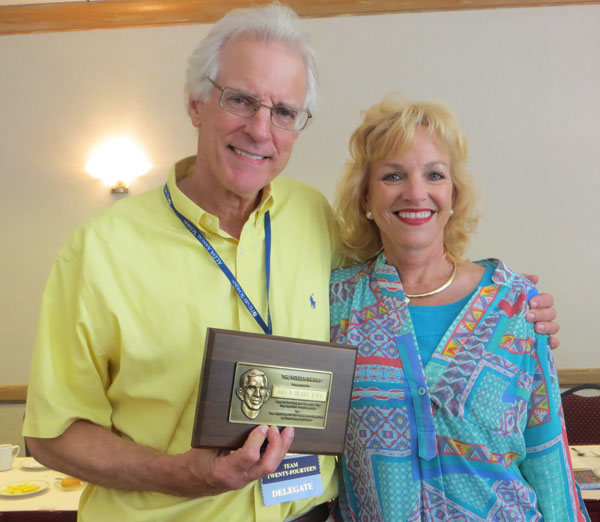 Joel Hearn with his wife, Daryl, after winning the 2013 H. Moren Fuller Award—Alabama's highest dental professional honor—from the UAB School of Dentistry Alumni Association. Photo by Charlene Phillips.
Joel Hearn with his wife, Daryl, after winning the 2013 H. Moren Fuller Award—Alabama's highest dental professional honor—from the UAB School of Dentistry Alumni Association. Photo by Charlene Phillips.
Hearn has always loved music. Even after graduating from the UAB School of Dentistry in 1972 and serving in the U.S. Air Force for three years, the Tuscaloosa native pursued a career as a professional musician—briefly. “I spent six months playing the piano in restaurants in Charleston, South Carolina,” Hearn told Norma Butterworth-McKittrick in UAB Magazine in 2009. “That’s when dentistry started to look pretty good, because music—well, when you have to do it, it’s not as much fun.”
So Hearn spent three years practicing general dentistry, then returned to UAB in 1978 for a two-year residency in endodontics, which concerns root canals and diseases of the pulp. “It was a source of great education, mentorship, and long-lasting friendships,” he recalls.
It was also a time of civic pride, with UAB’s new basketball team hitting the hardwood. The university held a contest to find its first official fight song to use as a rallying cry on the court. “They offered a prize of $150,” Hearn remembers. “I was broke at the time, so I thought, ‘Hey, I could do this.’” Hearn says his composition was a change from his usual rock ‘n’ roll, but it topped pieces from a number of music students and professional musicians. He recorded the demo using a cassette tape player, a piano, and family members on vocals.
Hearn’s fellow dental residents and department chair cheered his win, and even accompanied him to collect his prize. “They had not only a photographer but the whole band to play the song,” Hearn recalls. “It was a fabulous arrangement of it; it sounded great.”
Dentists in Florence recruited him to open the city’s first endodontics practice. Hearn recently retired after 36 years there, though he continues to serve on the School of Dentistry’s Leadership Council and keep up with fellow alumni. “Some of my best friends in the world are in the class of ’72,” he says. “We’ve stayed together over the years.”
Hearn looks forward to playing more music in his retirement—and, of course, enjoying his most famous work. “It was crazy,” says Hearn, recalling his experience creating the Blazers’ signature sound. “But years later I still get to hear it on national television.”
Another competition, this time in 2003, gave UAB its alma mater. Trussville native David McNeeley, a music producer and former music teacher, wrote and composed the song, selected from among 42 submissions by a committee of alumni and faculty.
“The music part is the easy part; the words are the harder part,” explained McNeeley in UAB’s announcement of the alma mater. “For some people, this just flows out of them. I worked very hard at it, trying to get it right.” Creating the alma mater took several weeks, he added. The Marching Blazers first performed the “UAB Alma Mater” at the Homecoming football game on November 1, 2003.
“Blazer Victory,” another favorite tune of UAB sports fans, was written “to sound like a turn-of-the-century piece,” said Danny Doyle, Ed.D., in a 1998 UAB Magazine. Doyle, then the director of the Marching Blazers band, composed the song to help encourage an appreciation for tradition among the student musicians. At that time, the marching band itself was new, debuting just four years earlier with 140 members under the direction of Clifford (Ski) Winter III, Ph.D., associate professor of music.
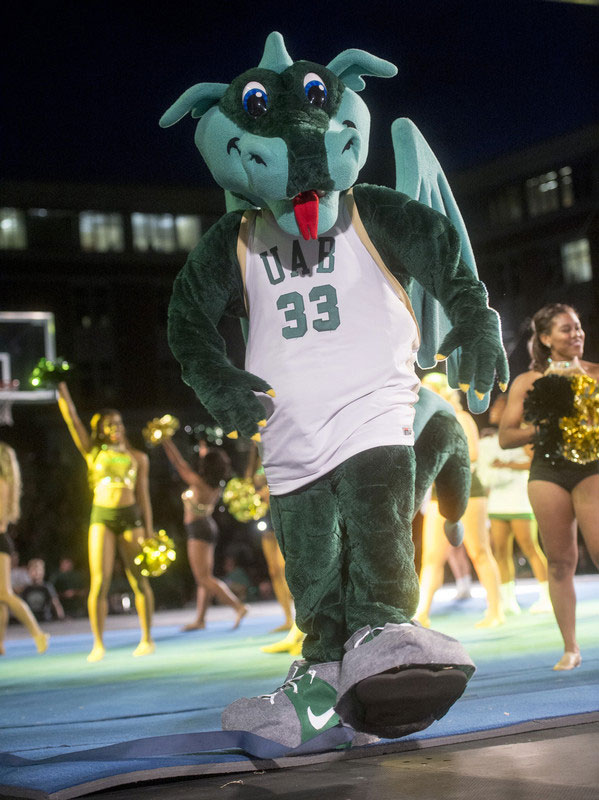 Blaze entertains a crowd on the Campus Green during Homecoming 2015. Photo by Steve Wood.
Blaze entertains a crowd on the Campus Green during Homecoming 2015. Photo by Steve Wood.
BLAZE
When the newly named Blazers took to the basketball court for the first time in 1978, a dragon mascot accompanied them—but today’s Blaze fans wouldn’t recognize him. This dragon was furry, pink, nameless, and, according to an article written by student Jeane Malone in UAB’s 1981 Phoenix yearbook, unpopular from the moment he popped out of a box at a game.
By the next basketball season, Beauregard T. Rooster was strutting around the sidelines. According to Malone, the bird originated as a homemade Halloween costume that caught the attention of Gene Bartow, the legendary basketball coach and founding father of UAB athletics.
Beauregard entertained Blazer fans of all ages with his antics throughout the 1980s, performing with the cheerleaders and Golden Girls, putting fans’ heads in his beak, and often holding up an eye chart to test the vision of game referees.
So what happened to the orange-feathered fowl with the big beak? “Legend has it, though we have no confirmation in our resources here, that Bartow and others felt a chicken was not the appropriate mascot for UAB once we had an NCAA Division III football team in 1991,” says Tim Pennycuff, UAB archivist and associate professor. “Documents also indicate concerns that the beloved rooster resembled too closely the famous San Diego chicken. Likely, it was a combination of the two.”
In 1993, an imposing Viking named Blaze landed on the court. But his tendency to frighten children made his stay a short one. Three years later, another Blaze—the fun, familiar, friendly green dragon—rolled into town, right after UAB’s elevation to Division I-A. He has been delighting fans ever since at athletic events and other happenings across campus and in the community. He’s even finding followers on
Twitter,
Instagram,
Facebook, and
YouTube, where he shares his adventures in firing up school spirit.
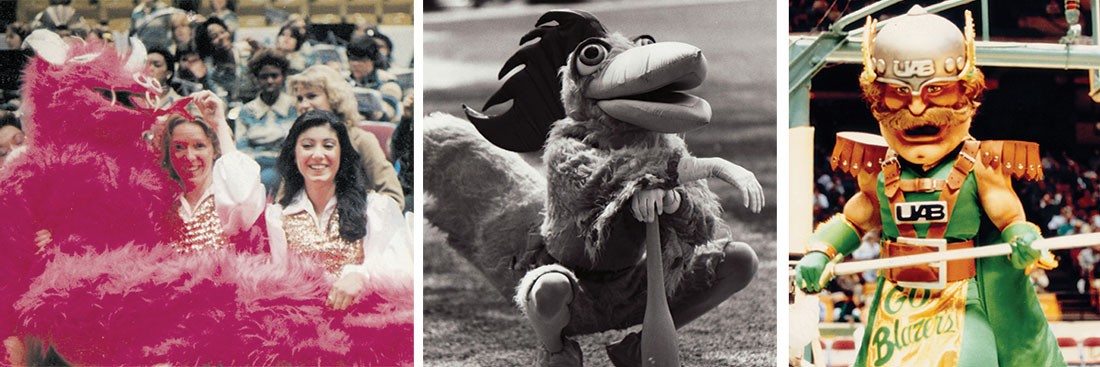 (Left to right) The unnamed pink dragon attempts to charm; Beauregard T. Rooster watches a game; Blaze the Viking storms the court. Photos courtesy of UAB Archives.
(Left to right) The unnamed pink dragon attempts to charm; Beauregard T. Rooster watches a game; Blaze the Viking storms the court. Photos courtesy of UAB Archives.
GURNEY DERBY
Each fall, a most unusual competition clatters along a street on UAB’s campus. Teams of two men and two women push old hospital gurneys, each one draped with decorations and carrying a silent “passenger,” up and down the course in a race for Homecoming glory. Crowds line the curbs and cheer for the teams, often dressed in costumes and sporting imaginative names—Hemoglobin Trotters; Public Enema; or Too Fast, Too Femorous, for instance.
The beloved Gurney Derby, a nod to UAB’s history and health-care prowess, attracts teams representing schools, departments, and organizations across campus; around 20 competed in 2016. Prizes include awards for the champs and runners-up, the best dressed gurney, and the most creative passenger. The “Dead Last” award—a hubcap—goes to the team squeaking in at the end.
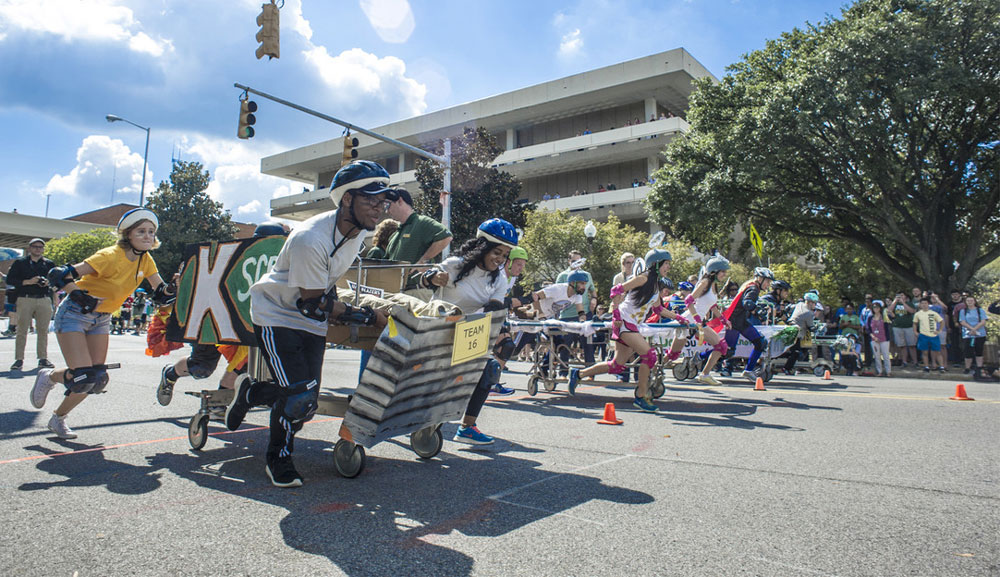 Teams race across the starting line at the 2015 Gurney Derby during Homecoming. Photo by Steve Wood.
Teams race across the starting line at the 2015 Gurney Derby during Homecoming. Photo by Steve Wood.
HOMECOMING
Homecoming in January? For 15 years following the first one in 1979, Homecoming was aligned with UAB basketball, giving students, alumni, and the city a reason to celebrate in the middle of winter. Early editions of Homecoming featured familiar events such as the bonfire, but also banquets, a dance for alumni and students, academic lectures, and something known as the “Jell-O Olympics” in addition to the marquee basketball game. UAB actually held two Homecomings in 1994—one in January and the other in October—as the celebration switched seasons to follow the growth of UAB football.
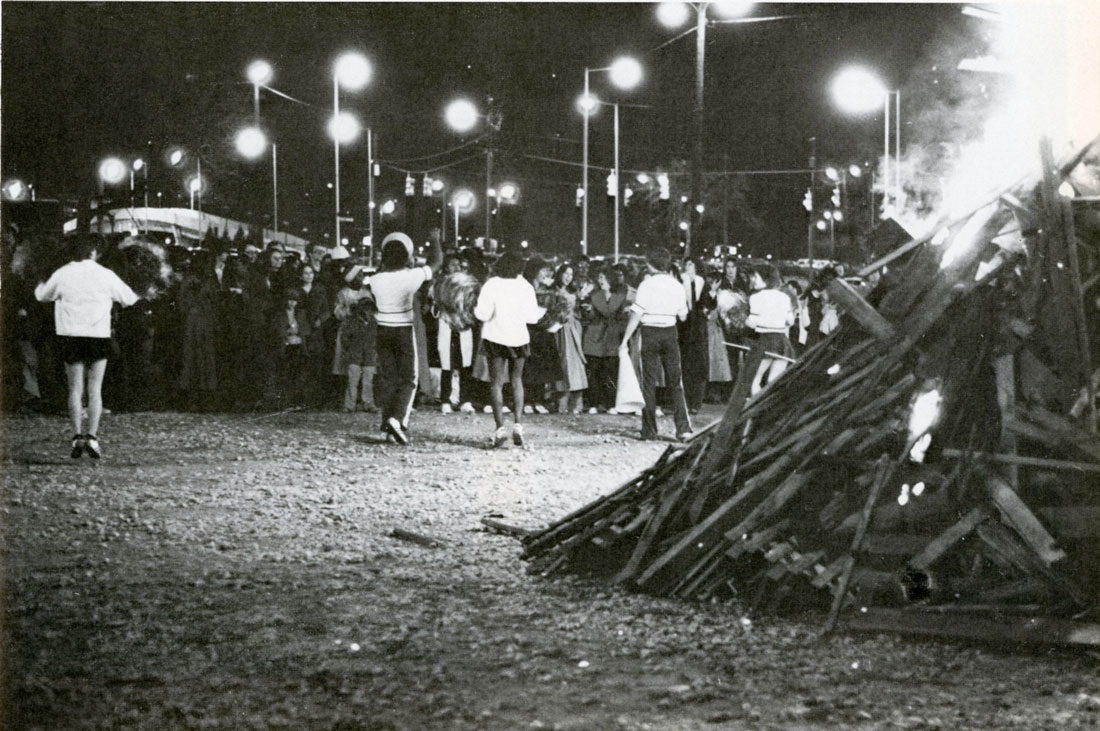 A bonfire lights the night during UAB's first Homecoming in January 1979. Photo from 1979 Phoenix yearbook, courtesy of UAB Archives.
A bonfire lights the night during UAB's first Homecoming in January 1979. Photo from 1979 Phoenix yearbook, courtesy of UAB Archives.
The National Alumni Society added the
Mr. and Ms. UAB competition, one of Homecoming’s most enduring traditions, in 1981 to honor students demonstrating scholastic achievement, leadership, and involvement both on campus and in the community. Chemistry majors David Bolus (now an assistant professor in UAB’s Department of Radiology) and Kay Ellis were the first winners. One thing certainly has changed over the years—the size of the scholarship each winner receives. Today it’s $2,500; in 1981, it was $250.
GANG GREEN
Students have been cheering loudly for the Blazers since the very first game, but one group has kept the stands rocking since 2001. That’s when
Gang Green made its first appearance as a spirit group for men’s basketball. Today the student-led organization, backed by the UAB Bookstore, uses its voice to fire up the home advantage for all of UAB athletics.
For years, engineering student Jeremiah Haswell was the face of Gang Green. His green-wigged visage, captured mid-shout, appeared on everything from t-shirts to scoreboards.
UAB Magazine followed up with Haswell in 2011; today, he works in nuclear development for Georgia Power.
UAB FOOTBALL
Just months away from its return to competition,
UAB’s football team has become the latest example of Birmingham’s resurgence—and a national feel-good sports story. That’s a long way from the late 1970s, when Richard Dewberry, an undergraduate business administration student and football fan from Birmingham, became a frequent visitor to the office of Gene Bartow.
“I was always up there, bugging Coach Bartow to start a football team—even before the basketball team started playing,” Dewberry recalls.
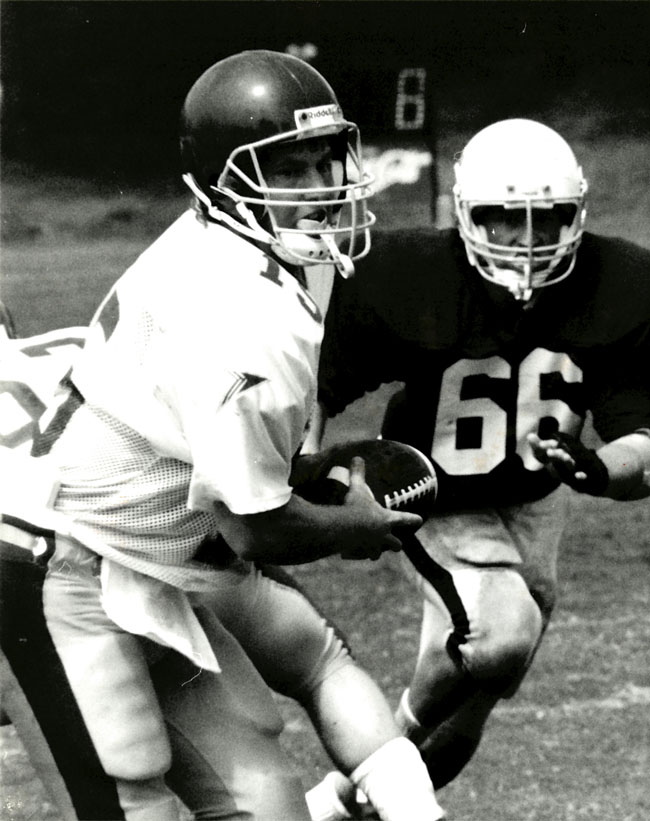 Blazer quarterback Doug Gann (left) plays against Millsaps College in UAB's first NCAA football game, on September 7, 1991, in Jackson, Mississippi. Photo courtesy of UAB Archives.
Blazer quarterback Doug Gann (left) plays against Millsaps College in UAB's first NCAA football game, on September 7, 1991, in Jackson, Mississippi. Photo courtesy of UAB Archives.
But why was football so important? “I love UAB and wanted to see it grow,” says Dewberry, who served as SGA president in 1978. When he was in school, “a lot of people would come to UAB, take their classes, and leave,” he recalls. But a growing number of students “wanted more of a traditional university experience” and worked to create it by developing student organizations, events, and traditions. “I knew football would be something everybody could rally around. It also generates publicity. I wanted that for UAB.”
After his 1979 graduation, Dewberry began a long career in real estate, but he continued supporting UAB—and the idea of a football team. In 1985, he sent Bartow and then-President S. Richardson Hill Jr., M.D., a multipage proposal, signing it “UAB Football Fan #1.” By the end of the next year, the Alliance to Bring Division I Football to UAB (founded by Dewberry and SGA president Casey Jones) had won the backing of local politicians, including a unanimous resolution of support from the Birmingham City Council.
“From there we decided to do a series of pep rallies and informational hearings, and shortly afterward, we put together a club team as a way to get it started,” Dewberry says. The club team kicked off its first game on October 1, 1989. Over the next several years, the team grew into an NCAA Division III team, then moved to Division I-AA, and finally, in 1996, Division I-A, playing its first game against Auburn.
Dewberry says he is happy and thankful for UAB Football’s rebirth—and for the community leaders who led the charge to support the team. And he can’t wait for the first game of the 2017 season on Sept. 2. “If you back a team into a corner, they’re going to fight their way out,” he says. “And that’s how I feel about this football team. They may not win every game, but they’re going to let people know they were there.”
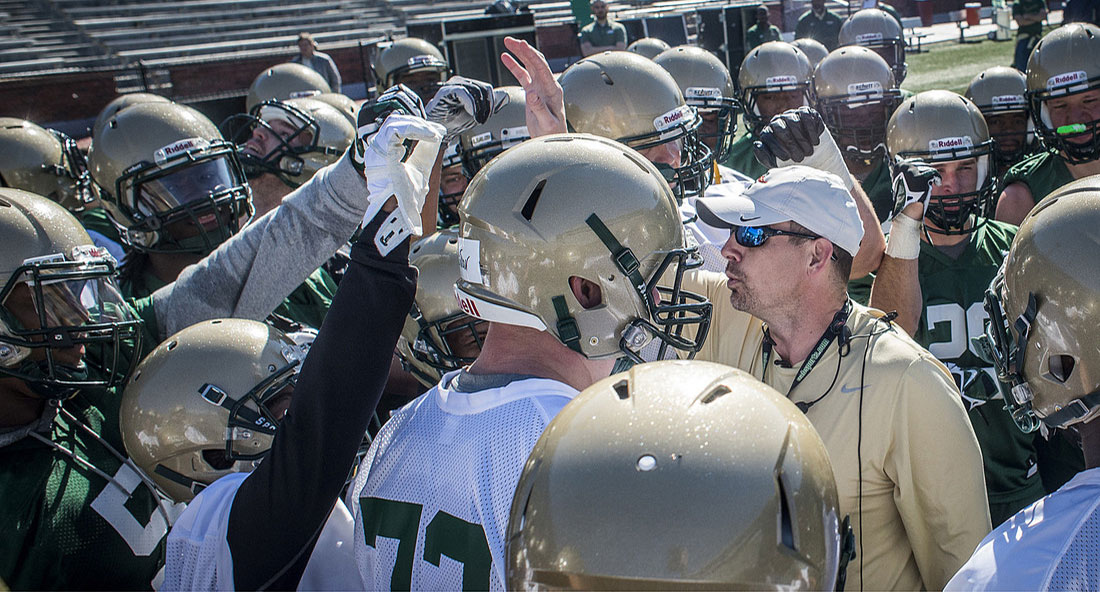 Head football coach Bill Clark meets with players following the team's return to the field for its first spring practice in 2016. Photo by Steve Wood.
Head football coach Bill Clark meets with players following the team's return to the field for its first spring practice in 2016. Photo by Steve Wood.
Share Your Stories
Got some fun memories about a Blazer tradition or your own years attending school at UAB?
Send them in! They might show up in a future
UAB Magazine story.
Published January 2017
 Bartow Arena is awash in green and gold at the 2011 commencement ceremony. UAB actually has three official colors: green and white, with gold as the accent color. Photo by Steve Wood.
Bartow Arena is awash in green and gold at the 2011 commencement ceremony. UAB actually has three official colors: green and white, with gold as the accent color. Photo by Steve Wood.  (Left to right) Alumni Tommy Burns, Richard Dewberry, and Chuck Snow, who helped establish iconic UAB traditions as students, show their school spirit at the UAB Bookstore. UAB’s colors aren’t Snow’s only lasting cultural contribution: As a student on the entertainment committee, he hired a young, little-known band—the Commodores, led by Lionel Richie—to headline a party for UAB nursing students. After they played in a basement room on campus, Snow introduced the band to its first booking agency. Photo by Steve Wood.
(Left to right) Alumni Tommy Burns, Richard Dewberry, and Chuck Snow, who helped establish iconic UAB traditions as students, show their school spirit at the UAB Bookstore. UAB’s colors aren’t Snow’s only lasting cultural contribution: As a student on the entertainment committee, he hired a young, little-known band—the Commodores, led by Lionel Richie—to headline a party for UAB nursing students. After they played in a basement room on campus, Snow introduced the band to its first booking agency. Photo by Steve Wood.  Even the scientists in UAB's Center for Nanoscale Materials and Biointegration show their Blazer spirit. Photo by Steve Wood.
Even the scientists in UAB's Center for Nanoscale Materials and Biointegration show their Blazer spirit. Photo by Steve Wood.  Joel Hearn with his wife, Daryl, after winning the 2013 H. Moren Fuller Award—Alabama's highest dental professional honor—from the UAB School of Dentistry Alumni Association. Photo by Charlene Phillips.
Joel Hearn with his wife, Daryl, after winning the 2013 H. Moren Fuller Award—Alabama's highest dental professional honor—from the UAB School of Dentistry Alumni Association. Photo by Charlene Phillips.  Blaze entertains a crowd on the Campus Green during Homecoming 2015. Photo by Steve Wood.
Blaze entertains a crowd on the Campus Green during Homecoming 2015. Photo by Steve Wood.  (Left to right) The unnamed pink dragon attempts to charm; Beauregard T. Rooster watches a game; Blaze the Viking storms the court. Photos courtesy of UAB Archives.
(Left to right) The unnamed pink dragon attempts to charm; Beauregard T. Rooster watches a game; Blaze the Viking storms the court. Photos courtesy of UAB Archives.  Teams race across the starting line at the 2015 Gurney Derby during Homecoming. Photo by Steve Wood.
Teams race across the starting line at the 2015 Gurney Derby during Homecoming. Photo by Steve Wood.  A bonfire lights the night during UAB's first Homecoming in January 1979. Photo from 1979 Phoenix yearbook, courtesy of UAB Archives.
A bonfire lights the night during UAB's first Homecoming in January 1979. Photo from 1979 Phoenix yearbook, courtesy of UAB Archives.  Blazer quarterback Doug Gann (left) plays against Millsaps College in UAB's first NCAA football game, on September 7, 1991, in Jackson, Mississippi. Photo courtesy of UAB Archives.
Blazer quarterback Doug Gann (left) plays against Millsaps College in UAB's first NCAA football game, on September 7, 1991, in Jackson, Mississippi. Photo courtesy of UAB Archives.  Head football coach Bill Clark meets with players following the team's return to the field for its first spring practice in 2016. Photo by Steve Wood.
Head football coach Bill Clark meets with players following the team's return to the field for its first spring practice in 2016. Photo by Steve Wood. 